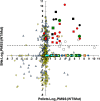The Aeromonas salmonicida subsp. salmonicida exoproteome: determination of the complete repertoire of Type-Three Secretion System effectors and identification of other virulence factors
- PMID: 24073886
- PMCID: PMC3852671
- DOI: 10.1186/1477-5956-11-42
The Aeromonas salmonicida subsp. salmonicida exoproteome: determination of the complete repertoire of Type-Three Secretion System effectors and identification of other virulence factors
Abstract
Background: Aeromonas salmonicida subsp. salmonicida, the etiologic agent of furunculosis, is a major pathogen of fisheries worldwide. Several virulence factors have been described, but the type-three secretion system (T3SS) is recognized as having a major effect on virulence by injecting effectors directly into fish cells. In this study we used high-throughput proteomics to display the differences between in vitro secretome of A. salmonicida wild-type (wt, hypervirulent, JF2267) and T3SS-deficient (isogenic ΔascV, extremely low-virulent, JF2747) strains in exponential and stationary phases of growth.
Results: Results confirmed the secretion of effectors AopH, AexT, AopP and AopO via T3SS, and for the first time demonstrated the impact of T3SS in secretion of Ati2, AopN and ExsE that are known as effectors in other pathogens. Translocators, needle subunits, Ati1, and AscX were also secreted in supernatants (SNs) dependent on T3SS. AopH, Ati2, AexT, AopB and AopD were in the top seven most abundant excreted proteins. EF-G, EF-Tu, DnaK, HtpG, PNPase, PepN and MdeA were moderately secreted in wt SNs and predicted to be putative T3 effectors by bioinformatics. Pta and ASA_P5G088 were increased in wt SNs and T3-associated in other bacteria. Ten conserved cytoplasmic proteins were more abundant in wt SNs than in the ΔascV mutant, but without any clear association to a secretion system. T1-secreted proteins were predominantly found in wt SNs: OmpAI, OmpK40, DegQ, insulinase ASA_0716, hypothetical ASA_0852 and ASA_3619. Presence of T3SS components in pellets was clearly decreased by ascV deletion, while no impact was observed on T1- and T2SS. Our results demonstrated that the ΔascV mutant strain excreted well-described (VapA, AerA, AerB, GCAT, Pla1, PlaC, TagA, Ahe2, GbpA and enolase) and yet uncharacterized potential toxins, adhesins and enzymes as much as or even more than the wt strain. Other putative important virulence factors were not detected.
Conclusions: We demonstrated the whole in vitro secretome and T3SS repertoire of hypervirulent A. salmonicida. Several toxins, adhesins and enzymes that are not part of the T3SS secretome were secreted to a higher extent in the extremely low-virulent ΔascV mutant. All together, our results show the high importance of an intact T3SS to initiate the furunculosis and offer new information about the pathogenesis.
Figures





Similar articles
-
The Aeromonas salmonicida subsp. salmonicida exoproteome: global analysis, moonlighting proteins and putative antigens for vaccination against furunculosis.Proteome Sci. 2013 Oct 15;11(1):44. doi: 10.1186/1477-5956-11-44. Proteome Sci. 2013. PMID: 24127837 Free PMC article.
-
Antigens of the type-three secretion system of Aeromonas salmonicida subsp. salmonicida prevent protective immunity in rainbow trout.Vaccine. 2013 Oct 25;31(45):5256-61. doi: 10.1016/j.vaccine.2013.08.057. Epub 2013 Sep 5. Vaccine. 2013. PMID: 24012573
-
Aeromonas salmonicida type III secretion system-effectors-mediated immune suppression in rainbow trout (Oncorhynchus mykiss).Fish Shellfish Immunol. 2017 Jan;60:334-345. doi: 10.1016/j.fsi.2016.12.006. Epub 2016 Dec 5. Fish Shellfish Immunol. 2017. PMID: 27923746
-
Virulence, genomic features, and plasticity of Aeromonas salmonicida subsp. salmonicida, the causative agent of fish furunculosis.Vet Microbiol. 2014 Feb 21;169(1-2):1-7. doi: 10.1016/j.vetmic.2013.06.025. Epub 2013 Jul 9. Vet Microbiol. 2014. PMID: 23890675 Review.
-
Aeromonas salmonicida subsp. salmonicida in the light of its type-three secretion system.Microb Biotechnol. 2014 Sep;7(5):381-400. doi: 10.1111/1751-7915.12091. Epub 2013 Oct 7. Microb Biotechnol. 2014. PMID: 24119189 Free PMC article. Review.
Cited by
-
Genomic Analysis of Aeromonas salmonicida ssp. salmonicida Isolates Collected During Multiple Clinical Outbreaks Supports Association with a Single Epidemiological Unit.Pathogens. 2024 Oct 17;13(10):908. doi: 10.3390/pathogens13100908. Pathogens. 2024. PMID: 39452779 Free PMC article.
-
Insight into the mobilome of Aeromonas strains.Front Microbiol. 2015 May 27;6:494. doi: 10.3389/fmicb.2015.00494. eCollection 2015. Front Microbiol. 2015. PMID: 26074893 Free PMC article. Review.
-
Subunit vaccine candidates against Aeromonas salmonicida in rainbow trout Oncorhynchus mykiss.PLoS One. 2017 Feb 9;12(2):e0171944. doi: 10.1371/journal.pone.0171944. eCollection 2017. PLoS One. 2017. PMID: 28182704 Free PMC article.
-
Multi-Organ Transcriptome Response of Lumpfish (Cyclopterus lumpus) to Aeromonas salmonicida Subspecies salmonicida Systemic Infection.Microorganisms. 2022 Oct 26;10(11):2113. doi: 10.3390/microorganisms10112113. Microorganisms. 2022. PMID: 36363710 Free PMC article.
-
Delivering the pain: an overview of the type III secretion system with special consideration for aquatic pathogens.Vet Res. 2021 Dec 19;52(1):146. doi: 10.1186/s13567-021-01015-8. Vet Res. 2021. PMID: 34924019 Free PMC article. Review.
References
-
- Dacanay A, Boyd JM, Fast MD, Knickle LC, Reith ME. Aeromonas salmonicida Type I pilus system contributes to host colonization but not invasion. Dis Aq Org. 2010;88:199–206. - PubMed
LinkOut - more resources
Full Text Sources
Other Literature Sources
Molecular Biology Databases
Miscellaneous

